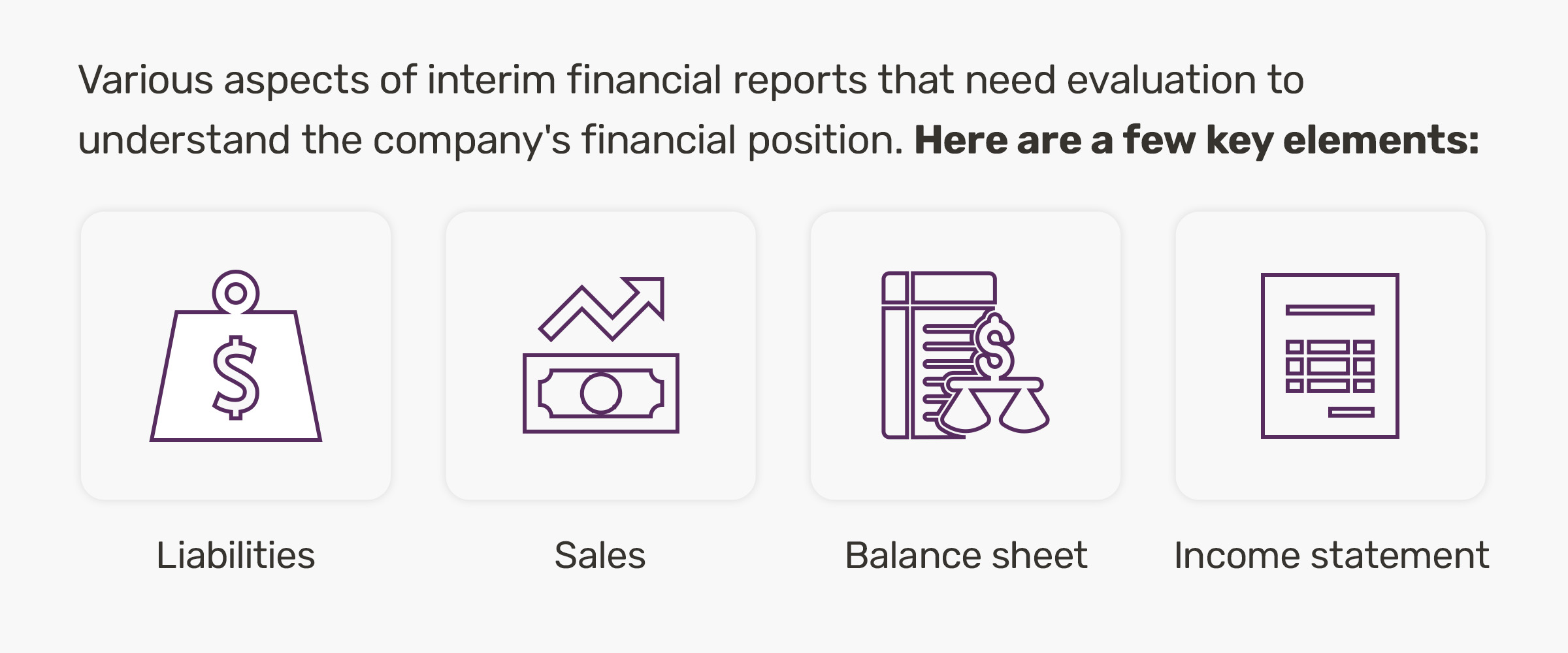Interim financial reporting is excellent for helping businesses stay aware of their finances before creating their annual financial report. It can help companies better control budgets and protect them from future issues with revenue, cash flow and equity.
These mid-year financial checkups can benefit your company in various ways when you know how to interpret these reports and plan for checkups effectively. This guide explores how to execute interim financial reporting and what to consider when performing a mid-year checkup.
What Is Interim Financial Reporting?
Interim financial reporting occurs when a company publishes or creates a complete set of financial statements for a period that is less than a full financial year. IAS 34 outlines the minimum content an interim financial report should contain and specifies measurement and accounting recognition principles for any interim financial report.
While IAS 34 does not specify which entities should publish an interim financial report, if an entity does choose to publish an interim financial report, it must adhere to the rules of IAS 34. The rule may also apply to entities using IFRS Standards in their annual financial statements when they publish an interim financial report to prove their compliance with IFRS Standards. Still, this report is useful for conveying a company’s performance before the end of full-year reporting cycles. It also keeps analysts and shareholders up-to-date and informs the public of any material changes.
Interim Financial Reporting Examples
Interim financial reports can be performed mid-year, quarterly or monthly. Doing these reports in under a year allows companies to see current trends and weaknesses in the business. They are particularly helpful if a company fell short of its financial goals in the previous year and wants to evaluate how that occurred. Here are four examples of how a business might execute interim financial reporting.
Compare Year-to-Date Revenue
One way to do interim financial reporting is to compare your company’s year-to-date revenue for the current year with the same period from the previous year. Doing so will allow you to spot the differences and investigate if certain aspects of the business are not performing as well as they did in the previous year.
Evaluate Your Annual Budget for the Current Year
Another way to review interim results is to compare your annual budget for the current year with your year-to-date revenue for the current year. This review can help you see whether you are over or under the budget. Depending on your results, you may opt to cut costs, incorporate more affordable equipment and services, implement a new marketing campaign, include a sales incentive or adjust your pricing.
Review Your Gross Margin
Calculate the company’s gross margin by subtracting the cost of goods sold from its total revenue and dividing the answer by the revenue. This will help you establish whether the margin is slipping compared to the previous year’s margin or industry benchmarks.
Evaluate the Balance Sheet
You can get a closer look at where financial challenges are coming from right away by reviewing the major categories of assets and liabilities in the balance sheet to detect working capital issues before they build up. For instance, you might find that the company’s line of credit is growing or there are revenue collection issues.
What Can Cause Negative Company Interim Financials?
While negative results can be due to daily business operations issues, they are sometimes caused by incorrect accounting practices. This may occur during low-priority internal interim reports, which may only loosely interpret period cutoffs and use estimates. A CPA may often correct these when they perform year-end reports because their reports are accurate.
This makes it essential to maintain consistent accounting practices between interim and year-end financial reporting. Interim financial reports should include all items a year-end report would, such as accurate accrued expenses, income taxes, bad debt write-offs, prepaid items and management bonuses.
How to Interpret Information From Financial Reports
Various aspects of interim financial reports that need evaluation to understand the company’s financial position. Here are a few key elements:

- Liabilities: Evaluate company expenses — such as debt payments, outstanding payroll expenses, taxes, rent and utilities — and compare them with the company’s budget.
- Sales: Reviewing sales income allows the company to understand its profitability and ability to meet long- and short-term financial goals.
- Balance sheet: The balance sheet is an important statement that helps you establish your revenue, debts and loans for an interim period.
- Income statement: The income or profit and loss statement summarizes the impact of revenue, expenses, gain and loss for a set period and helps you understand financial trends and business activities.
Tips for Boosting Your Financial Health
If you’re planning to do a mid-year financial checkup, there are five important aspects you may need to consider.
1. Assess Your Budget
Review the budget you set at the beginning of the year and double-check whether the amounts are accurate. Compare the budget with the company’s current cash flow, then make the necessary changes to stay on track for the rest of the year.
2. Check Your Credit Report
Examine your credit report for any potential errors that could impact your credit score. If any accounts were reported inaccurately or you suspect there might be fraudulent activity, addressing the issues promptly may help you enhance the accuracy of your interim financial report.
3. Prioritize Paying Down Debt
Evaluate outstanding debts, such as loans, credit card payments and mortgages and consider the payment terms, balances and current interest rates for each. Based on your findings, create an efficient debt payment plan that might lower your monthly payment obligations.
4. Create a Savings Strategy
If you expect to have larger expenses in the second half of the year, it may help to start saving funds or exploring financing options in advance. Review your progress regularly and make the necessary adjustments to meet those long-term goals.
5. Set up a Review Process
Financial planning is an ongoing process, so it is essential that after you put plans in place after the mid-year checkup, you set up a recurring review schedule to ensure those plans stay on track. This will also help you stay financially informed.
Receive Assistance With Your Mid-Year Financial Checkup From SD Mayer
If you plan to evaluate your finances with an interim financial report, SD Mayer can help. We are an accounting and advisory firm that can improve the accuracy of your mid-year report. Our specialists will interpret your report, detect and correct errors and present remedies for any larger issues.
We offer various services that may help, such as budget creation and management, strategic planning to reduce financial issues and forecasting your financial needs. Contact our experts for professional and personalized assistance with interim financial reporting today.

Linked Sources:
- https://www.ifrs.org/issued-standards/list-of-standards/ias-34-interim-financial-reporting/
- https://www.sdmayer.com/resources/4-cost-cutting-areas-to-help-your-business-boost-profits/
- https://www.sdmayer.com/services/wealth-management/financial-planning/
- https://www.sdmayer.com/services/outsourced-and-managed-services/interim-accounting-assistance/
- https://www.sdmayer.com/services/outsourced-and-managed-services/budgeting/
- https://www.sdmayer.com/services/business-advisory/strategic-planning/
- https://www.sdmayer.com/contact/
SECURITIES AND ADVISORY DISCLOSURE:
Securities offered through Valmark Securities, Inc. Member FINRA, SIPC. Fee based planning offered through SDM Advisors, LLC. Third party money management offered through Valmark Advisers, Inc a SEC registered investment advisor. 130 Springside Drive, Suite 300, Akron, Ohio 44333-2431. 1-800-765-5201. SDM Advisors, LLC is a separate entity from Valmark Securities Inc. and Valmark Advisers, Inc. Form CRS Link
DISCLAIMER:
This material has been prepared for informational purposes only, and is not intended to provide, and should not be relied on for, accounting, legal or tax advice. The services of an appropriate professional should be sought regarding your individual situation.
HYPOTHETICAL DISCLOSURE:
The examples given are hypothetical and for illustrative purposes only.





